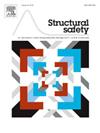Hierarchical Bayesian models with subdomain clustering for parameter estimation of discrete Bayesian network
IF 6.3
1区 工程技术
Q1 ENGINEERING, CIVIL
引用次数: 0
Abstract
Bayesian network (BN) is a powerful tool for the probabilistic modeling and inference of multiple random variables. While conditional probability tables (CPTs) of a discrete BN provide a unified representation facilitating closed-form inference by efficient algorithms, they pose challenges in parameter estimation, especially due to data sparsity resulting from the discretization of continuous parent variables. To address the challenges, this paper presents a novel BN modeling approach, which is the first attempt to apply hierarchical Bayesian modeling to quantify the CPT of a child variable with discretized multiple parent variables. In addition, given that discretization results in many subdomains showing strong correlation, the concept of subdomain clustering is introduced in both supervised and unsupervised learning schemes. The proposed procedure is demonstrated by its application to the BN model describing structural responses under a sequence of main and aftershocks. In the model, the structural dynamic response of interest is modeled by a CPT in discretized domains of six-dimensional ground motion features. Hierarchical Bayesian normal models are developed to quantify the conditional probability parameters in the subdomains, which are classified using the information of peak ground acceleration. The proposed approach facilitates robust parameter estimation of the CPT, especially in the subdomains with a small number of data points. This is thoroughly validated by comparing the inference results of the CPT by the proposed method with those by an alternative approach that does not consider the correlation between subdomains. Furthermore, the validation is performed on different subsets of the parent variables with various unsupervised learning schemes to demonstrate the general effectiveness of the subdomain clustering for the hierarchical Bayesian approach.
离散贝叶斯网络参数估计的子域聚类层次贝叶斯模型
贝叶斯网络是多随机变量概率建模和推理的有力工具。虽然离散BN的条件概率表(cpt)提供了统一的表示,便于通过有效的算法进行封闭形式的推理,但它们在参数估计方面提出了挑战,特别是由于连续父变量的离散化导致的数据稀疏性。为了解决这些挑战,本文提出了一种新的BN建模方法,这是首次尝试应用分层贝叶斯建模来量化具有离散多父变量的子变量的CPT。此外,考虑到许多子域的离散化结果显示出很强的相关性,在有监督和无监督学习方案中都引入了子域聚类的概念。通过将所提出的程序应用于描述主余震和余震序列下结构反应的BN模型,证明了所提出的程序。在该模型中,目标结构的动力响应是在六维地震动特征的离散域中用CPT模型来模拟的。建立了层次贝叶斯正态模型来量化子域中的条件概率参数,并利用峰值地面加速度信息对子域进行分类。该方法有利于CPT参数的鲁棒估计,特别是在数据点较少的子域中。通过将所提出方法的CPT推理结果与不考虑子域之间相关性的替代方法的推理结果进行比较,彻底验证了这一点。此外,使用各种无监督学习方案对父变量的不同子集进行验证,以证明分层贝叶斯方法的子域聚类的一般有效性。
本文章由计算机程序翻译,如有差异,请以英文原文为准。
求助全文
约1分钟内获得全文
求助全文
来源期刊

Structural Safety
工程技术-工程:土木
CiteScore
11.30
自引率
8.60%
发文量
67
审稿时长
53 days
期刊介绍:
Structural Safety is an international journal devoted to integrated risk assessment for a wide range of constructed facilities such as buildings, bridges, earth structures, offshore facilities, dams, lifelines and nuclear structural systems. Its purpose is to foster communication about risk and reliability among technical disciplines involved in design and construction, and to enhance the use of risk management in the constructed environment
 求助内容:
求助内容: 应助结果提醒方式:
应助结果提醒方式:


